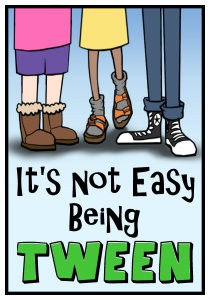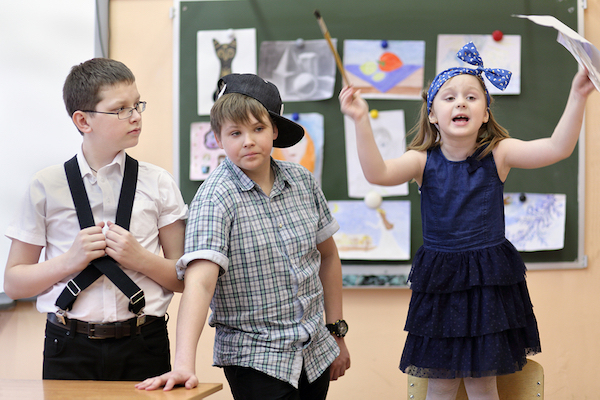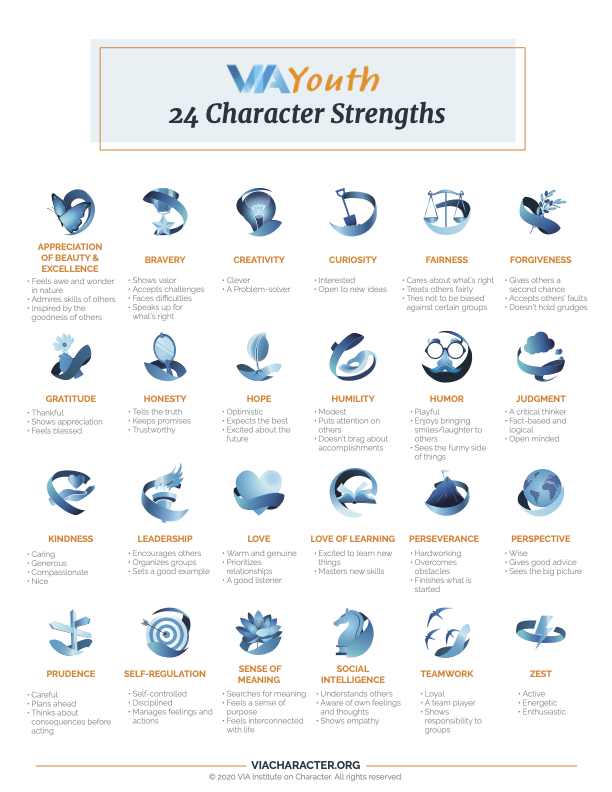Teaching Our Students to Value Their Strengths
A MiddleWeb Blog
 Last week I found myself in the uncomfortable situation of regretting something I’d said in a casual conversation. I had inadvertently shared information that I had assumed was public knowledge, and by the reaction of the other two in the room, it was not.
Last week I found myself in the uncomfortable situation of regretting something I’d said in a casual conversation. I had inadvertently shared information that I had assumed was public knowledge, and by the reaction of the other two in the room, it was not.
As generally happens when I’ve done something I regret, I tend to dwell on the event and mentally beat myself up over it for a day or two. Generally, I blame this on my psychology training and the fact that I tend to over-analyze behavior, but I also think this is a human trait.
On some level, humans are hard-wired to focus on the negative as a survival tool to be alert to threats.
This led me to think about the students in my classroom. If I as a grown, theoretically mature, adult can feel this way, how do 11 and 12-year-olds deal with the fallout when they’ve been less than their best selves?
How can I as a trusted adult help them through painful process and lead them out the other side toward positivity? I believe the answer lies in what those who practice positive psychology call “Strengths-Based Teaching.”
Authentic Self-Esteem
I’m sure those who grew up or taught school in the 1980s feel that Strengths-Based Teaching is a variation of the Self-Esteem Movement, but there are significant differences. The self-esteem movement taught children that they were valuable and loved NO MATTER WHAT.
Well-meaning practitioners believed in part that showing people they had inherent worth could help to solve society’s ills. There is nothing wrong with this goal, but the approach never really showed children authentic ways in which they could and should feel good about themselves.
Strengths-based teaching focuses more on the whole child and the areas in which they’ve demonstrated a talent or skill (such as creativity, curiosity, courage, musicality, athleticism, or honesty) and capitalizes on these.
In addition, this philosophy shows students that they have all of these facets to their personality, it’s just that some are more pronounced. Instead of defining underdeveloped facets as “weaknesses,” we need to frame them as growth opportunities (in effect, utilizing a true growth-mindset rather than just paying lip service).
By focusing more on what’s right with a child rather than what’s wrong, we are helping them gain authentic self-esteem rather than providing it artificially from an outside source. The goal is children who have an accurate vision of themselves as a learner and, more importantly, as a person. A worthy goal, indeed.
A Route to Equity
Another benefit of a Strengths-based approach (also known as Asset-based) is that it promotes equity. Numerous studies have shown that students from marginalized populations often don’t achieve to their true potential due to institutional or educator biases and practices.
For example, in my days as a special education teacher, students were often held back from advancing to challenging concepts such as Algebra that I knew they would understand because they did not do well or tests, or had behavior issues, or were from a group where the stereotype was that they couldn’t achieve in math. Had we focused on the child’s natural problem-solving strength vs. their deficits, they would have been allowed to advance in math.
How Can We Emphasize Assets?
There are many ways teachers can help students to recognize and appreciate their strengths.
1. Identify Their Strengths
There are many commercial programs and asset assessments out there, some free and some not, that are intended to allow individuals to self-identify their assets.
► One of my most trusted resources is CASEL – the Collaborative for Academic, Social, and Emotional learning. Their website provides an overview of what they believe to be SEL Core Competencies. The organization is currently working on an assessment of these competencies that should be available to the public soon. In the interim, an educator could make her own materials using their free resources to discuss the strengths with children.
► The Gallup organization sells a product that is widely used in schools called the Clifton Strengths Finder.
► One of the newer assessments is found at Thrively.com. They offer a free assessment for students. I have not explored this resource-rich website, but I know it is very popular.
► The Values in Action (VIA) Institute on Character provides a free 10-minute survey designed for youth that assesses their strengths in 24 character traits. I took the youth survey (available in 28 languages) myself to see the results and found them surprisingly accurate. I should mention that there are a few questions regarding faith and spirituality, but they were non-denominational and non-judgmental.
2. Strengths-based Opportunities
► In my classroom, I use the principles of Universal Design for Learning which guide us in making sure that all students successfully demonstrate their learning by providing myriad opportunities to do so and incorporating various strengths in lesson and assessments.
► At the beginning of the year, I give my students a survey. One of the questions I ask is “What are you most proud of” and I pay attention to their answers. I also ask “What are you really good at – perhaps even good enough to teach others?” I make a note of these and find ways to capitalize on these skills throughout the year.
► In addition, I allow students to pursue their ideas and capitalize on their talents via Passion Projects. When they present these to their peers in the spring, the true appreciation of what they’ve achieved fills them with a tremendous sense of accomplishment. Any activity where they pursue a passion will yield higher engagement and positive results.
3. Ask Peers and Teachers
► As educators, we are often asked to complete behavior and academic rating scales as an information-gathering step toward a possible diagnosis for individual education plans. Wouldn’t it be great if there were ways for teachers to share what they see as a student’s strengths?
I recall one year I had a particularly boisterous group of boys who began the year pushing back at my every request. They seemed to be led by one young man, who had a lot of great qualities. I just wanted him to use his powers for good.
So I pulled him aside and told him that I could tell he was a natural leader and that I could use his help getting the others on board. I also put a comment on his report card about showing leadership capabilities. Within a week of this, things really turned around and he was one of the best students I ever had. He even signed up for my elective class the following semester!
► I have also seen wonderful examples of activities such as one done in our sixth-grade health class. The desks are arranged in a circle. Each child puts their name on the top of a blank sheet of paper. The papers then rotate around the circle and each of their peers writes a brief statement about what they enjoy, appreciate, or admire about them.
At the end, they take some time to let all this soak in. Some are even moved to tears and nearly all of them keep this page for the rest of the year. We need to create more opportunities like this.
Create Goals
Recognizing growth opportunities is equally important in the strengths-based approach. Teach children how to write SMART goals or WOOP goals (still available at their legacy website) and work with them on plans to address the areas they’ve identified for improvement – recognizing this is about potential, not deficits.
Do Identity Work: My friend, Brent Gilson, wrote a lovely article here at MiddleWeb about his implementation of identity work in his classroom. It’s definitely worth a read.
Minimize Competition: I have written about this before, but I truly believe that the majority of competition in an academic setting does more harm than good. It forces students to focus on their deficits rather than their assets. Let students contribute their assets to collaborative ventures.
Prepare for Human Moments: As I said at the beginning, I am not always great at taking my own advice. However, I have a large support system and we take the time to lift one another up when there’s a need. I am also very good at sharing what I appreciate, admire, or enjoy about my friends, colleagues and family.
Because I know how easy it is to dwell on my negatives, I am grateful for those who help find my positives. I want to provide that same support system for my students. I am in their corner and I see their gifts. I just need to make sure they know this from the outset.







































Super post, Cheryl.
Think of the effect this activity would have for students on the day or two (depending on class size) before winter break. “The desks are arranged in a circle. Each child puts their name on the top of a blank sheet of paper. The papers then rotate around the circle and each of their peers writes a brief statement about what they enjoy, appreciate, or admire about them.”
Cheryl, thanks for writing about the effects of strength-based teaching. It’s great not only for students, but it also helps teachers maintain a positive attitude as they reframe how they see students. Its win-win for everyone. I thoroughly enjoyed this article. As always, thanks for what you write and for what you do in the classroom!